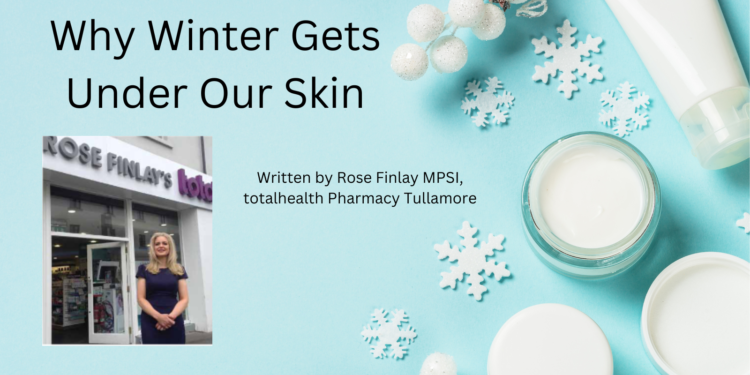With Autumn truly behind us, many of our patients and customers are beginning to seek advice on managing winter skin issues. While most of us will feel at least some effects of the cold weather on our skin, many skin conditions, such as psoriasis and eczema, also worsen significantly at this time of year. Understanding some of the causes of skin discomfort is important in helping our patients and customers to soothe and prevent irritation.
Written by Rose Finlay MPSI, totalhealth Pharmacy Tullamore

The skin is comprised of three layers:
• The outermost layer is the epidermis, which provides a waterproof barrier against the elements
• Beneath the epidermis is the dermis, which contains sweat glands, hair follicles, and connective tissue
• The deepest layer is the hypodermis, which is made up of fat and connective tissue. Each layer of the skin is impacted by the winter elements and requires increased care.
What is happening to the Skin in Winter?
As the largest organ in the body, the skin serves multiple functions, but one of the most important is that of protection. The skin acts as a barrier against harmful environmental elements and toxins. Several aspects of winter can impact on the skin’s protective performance. Temperature extremes, changes to diet and activity levels, and colder weather all mean the skin has to work harder.
Exposure to cold temperatures causes the blood vessels in the surface of the skin to narrow, in order to preserve heat. When exposed to warmth, the same blood vessels widen. During winter, when we come in from the cold to warmer temperatures quickly, the blood vessels at the skin’s surface can be put under more pressure due to the sudden increase in blood flow. Additionally, during colder temperatures, the production of lipids that help hydrate and nourish the skin begins to slow down. The production of filaggrin, a protein essential for maintaining barrier function and moisturising of the skin, also slows down in winter.
All of this combined with decreased humidity, exposure to indoor heating and less sunlight leads to dryer, tighter, and paler skin, as well as worsening of existing skin conditions. Complaints can include itching, flaking skin, redness, cracked lips, and dry scalp.
Skin Conditions in Winter
Existing skin conditions can all be affected by the winter elements, and many of our patients suffering from these conditions will seek additional advice in the coming months.
Eczema sufferers can experience more flare-ups during the winter months due to the decrease in humidity and the cold temperatures. Emollients are key in managing increased dryness. They will moisturise dryer skin and should also be used before going outside to prevent worsening symptoms.
Psoriasis symptoms can become activated when the body’s defences are put under pressure. Managing this condition can be much more difficult in winter, due to decreased humidity and reduced sunlight exposure. Psoriasis symptoms can also be brought on by illness, including colds and flus. Sufferers should be advised to increase their emollient usage, dress warmly to avoid temperature drops, and increase their water intake in order to avoid dehydration.
Chilblains present as red patches of blistering and swelling on the skin, resulting from exposure to extreme temperature changes, as blood flow levels fluctuate more rapidly. Sufferers should avoid trying to help their symptoms by rapidly warming up affected areas as this can make symptoms worse. Prevent chilblains by wrapping up warm to avoid exposure and taking OTC pain relievers if necessary.
Chapped Lips are common in colder weather and can be extremely uncomfortable. This is easily prevented by using a non-perfumed lip balm during the colder months, especially before exposure to cold conditions.
Winter Itch occurs as a result of increased dryness, so the skin becomes itchy and tight, sometimes also with a rash or scaly skin. While the symptoms can present in a similar way to eczema, winter itch is usually only experienced during colder weather. It can be prevented by ensuring increased moisturising with nonperfumed products. Sufferers should avoid wearing wool which can further irritate the skin.
Rosacea can be triggered by cold weather, causing redness as blood vessels become visible on the face. Sufferers should protect themselves against temperature fluctuations by wrapping up warm before going out and avoiding warming up too quickly. Gentle moisturisers will help, but steroid creams should be avoided.
Acne is usually associated with increased oil production, which we tend to think should be more under control during colder weather. But the dryness that winter can cause can also worsen acne, as an increase in the build up of dead skin can lead to clogged pores. Acne sufferers should ensure to be adherent to existing treatments during the winter months and use appropriate exfoliants to gently get rid of dead skin. While the skin may be uncomfortable or itchy, patients should try their best to avoid touching their skin too much to reduce the risk of bacteria affecting the skin.
Raynaud’s Disease can be drastically impacted by cold temperatures, with the extremities being most affected. Affected patients should be advised to avoid extremes of temperatures, by wrapping up warm and ensuring they never get too cold. If symptoms are severe, a GP should be consulted to avoid infection.
Dry Scalp or Dandruff can be worse during colder weather. Ensure patients are advised against the use of over-perfumed products. Opt for appropriate treatments and avoid over-washing the hair. Most dermatological brands offer shampoos that can keep symptoms at bay and soothe flare-ups.
Steps to Ease the Effects of Winter on the Skin
There are lots of steps your customers and patients can take to reduce the impact winter has on the skin, whether they have a skin condition or not.
Clothing is crucial. Firstly, for protection against the elements. Gloves, scarves, and hats should be worn outside to add a barrier of protection against the elements. Those suffering with uncomfortable skin symptoms should be advised to avoid irritating fabrics such as wool or flannel.
Avoid Extremes in Temperatures changes as much as possible. Not only cold but also heat. Turning up the central heating one or two notches might sound tempting but indoor heating can result in the skin heating up too quickly. Increased temperatures inside can also reduce humidity.
A Humidifier may be beneficial to those experiencing skin discomfort in winter. Indoor heating reduces humidity which can further dry out the skin. Dry skin conditions like eczema can also be soothed by increasing humidity.
Warm Showers or Baths are far kinder to skin that hot. While it may seem comforting to take a hot shower after being out in the cold, this can lead to temperature changes that are too much for the skin, but also to increased dryness. Make sure bathing is as short in duration as necessary. It is also advisable to pat dry after bathing rather than rubbing the skin with your towel. Use gentle, non-perfumed bathing products to avoid stripping the skin of natural oils. If exfoliation is needed, make sure to use gentle products for sensitive skin.
Prepare the Skin for cold exposure by increasing moisturisation. In general, the greasier a product is, the more protection against the cold it will offer. If suffering from skin conditions, always use appropriate products. Lip balm is also advisable during cold temperatures.
Skin Care Products should not necessarily be changed up too much for winter, to avoid any reactions to new products. Instead, advise your customers to change their regime slightly to ensure winter protection. Avoid harsh cleansers or scrubs, opting for gentler versions. Products containing retinol or vitamin C should be eased back during the winter. If using lotions for moisturisation, switch to a cream. Night-time products will assist in cell-regeneration and improve the skin’s natural barrier abilities.
Don’t forget the Body! It’s not all about the face. We should ensure all-over body care during the winter by using appropriate body moisturisers, particularly after bathing.
Hydration is crucial. We may not be inclined to drink as much water in the cold as during the summer. But the reduced humidity that winter brings means our skin can become dehydrated more easily. Hydrating from within is essential, particularly when our intake of hot drinks like tea and coffee can increase during the colder weather. These drinks cause further dehydration. Opting for herbal teas or water will make a big difference to the skin’s hydration levels.
Sun Protection is still required during the winter, sun or no sun! Although UV rays are weaker during the winter, they are still present. Moisturisers containing an SPF should be recommended, or the use of a facial suncream.
Alcohol intake can increase in the winter, particularly with longer nights and seasonal socialising. However, alcohol not only dehydrates you, it can also worsen conditions like eczema and psoriasis, increasing flareups. People should always be advised to stick with recommended unit intakes, and always avoid binge drinking. Tobacco smoke exposure in pubs or clubs will also irritate dry or uncomfortable skin.
Nutrition is as important to skin health as products. A healthy, balanced diet will ensure the skin gets all the nourishment it requires to function as it should. Vegetables are a crucial source of antioxidants that will further improve the skin’s effectiveness as a barrier to winter elements. Some specific vitamins believed to be important for skin health include:
• Vitamin D, which we primarily get from sunlight exposure. This is more difficult during the winter months, so supplementation is usually advised. Food sources of vitamin D may not be appropriate to provide the body with the levels required.
• Omega 3 is an essential fatty acid that serves many important functions, including skin hydration and ensuring appropriate oil production. Food sources of Omega 3 include oily fish, flaxseeds, walnuts, and chia seeds. Supplementation should be recommended for those who don’t enjoy oily fish.
• Vitamin E has antioxidant effects and helps protect the skin from exposure. While the body usually produces enough through the production of sebum, this can deplete in the winter months. Food sources of Vitamin E include sunflower seeds, almonds, and hazelnuts
• Vitamin C is also an important antioxidant and plays an essential role in collagenproduction. It is particularly essential for the epidermis to act as it should. Vitamin C sources include citrus fruits, broccoli, and spinach.
• Vitamin K is believed to improve the skin’s ability to heal. Good food sources include kale, green beans, cabbage, lettuce, and spinach.
To View the December Magzine, click here











